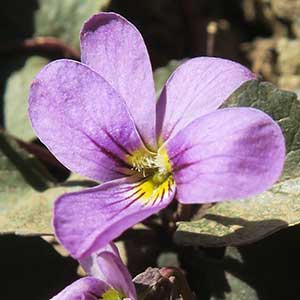Viola flettii
Viola howellii
Flett's violet, Olympic violet, rock violet
Howell's violet, violette de Howell
1–3, ascending to erect, mostly glabrous, on caudex from fleshy rhizome.
1–4, ascending to erect (sometimes later reclining to nearly prostrate), glabrous or sparsely pubescent, on caudex from subligneous rhizome.
basal and cauline;
basal: 1–3;
stipules linear-lanceolate, margins entire or with glandular processes, apex acuminate;
petiole 1.5–9.7 cm, mostly glabrous;
blade purple-tinted and –veined, broadly reniform to ovate, 0.9–2.4 × 1.2–4 cm, base cordate, margins finely crenate-serrate, eciliate, apex acute to obtuse, surfaces glabrous or sparsely pubescent along veins adaxially;
cauline similar to basal except: stipules ovate to lanceolate, margins entire or shallowly laciniate;
petiole 0.7–5.9 cm, usually glabrous;
blade 0.8–2.1 × 1.2–3.1 cm.
basal and cauline;
basal: 1–6;
stipules linear-lanceolate to oblong, margins mostly entire or laciniate with gland-tipped projections, apex acute to acuminate;
petiole 4–15 cm, glabrous or sparsely puberulent;
blade ovate to reniform, 1.9–6.8 × 2.1–6.4 cm, thin, base cordate, margins crenate, ciliate, apex acute to usually obtuse, surfaces glabrous or sparsely puberulent;
cauline similar to basal except: stipules linear-lanceolate or deltate to oblong, apex acute or long-acuminate;
petiole 1–4.5 cm;
blade 2–5.1 × 1.2–5.8 cm.
1.8–7.1 cm, usually glabrous.
2.8–17.8 cm, glabrous or sparsely pubescent.
sepals lanceolate, margins eciliate, auricles 0.5–1.5 mm;
petals soft reddish violet on both surfaces, all with yellow area basally, lower 3 dark violet-veined, lateral 2 bearded, lowest with white around yellow area, 10–15 mm, spur yellow, gibbous, 0.5–2 mm;
style head bearded; cleistogamous flowers axillary.
sepals lanceolate, margins ciliate or eciliate, auricles 1–2 mm;
petals violet to soft blue-violet on both surfaces, whitish basally, lower 3 dark violet-veined, lateral 2 densely bearded, lowest 14–23 mm, spur blue-violet to whitish, gibbous to elongated, 2.4–5 mm, usually less than 1/2 lowest petal, tip straight;
style head bearded; cleistogamous flowers axillary.
± spherical, 5–9 mm, glabrous.
ellipsoid, 7–11 mm, glabrous.
dark brown to brownish purple, 2.5–3 mm.
light brown, 2.1–2.8 mm.
= 40, 80.
Viola flettii
Viola howellii
Viola flettii is endemic to the Olympic Mountains of northwestern Washington. C. S. McCreary (2005) noted that although morphologically and ecologically distinct, V. cuneata, V. flettii, and V. ocellata are closely related.
(Discussion copyrighted by Flora of North America; reprinted with permission.)
Viola howellii is similar to V. adunca and usually occupies moister habitats along the western side of the Cascade Mountains (H. E. Ballard 1992). The first documented record of this species in California was recently reported from Siskiyou County (R. J. Little 2010).
(Discussion copyrighted by Flora of North America; reprinted with permission.)
- Local floras:
BC,
CA,
OR,
WA
- Local Web sites:
CalFlora,
CalPhotos,
Flora NW,
PNW Herbaria,
Turner Photog.
WildflowerSearch
iNaturalist (observations)
USDA Plants Database
- LBJ Wildflower Center
- SEINet
- Plants of the World Online
- Encyclopedia of Life
- Wikipedia
- Google Image Search


